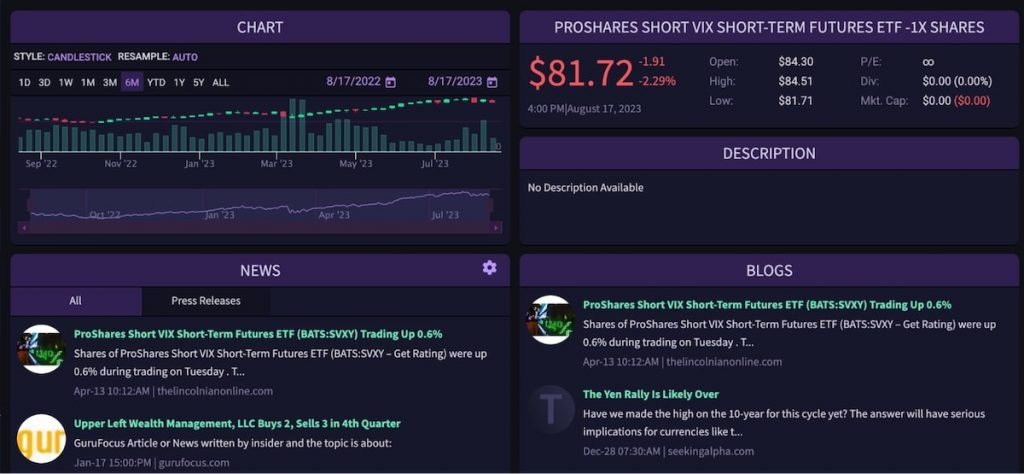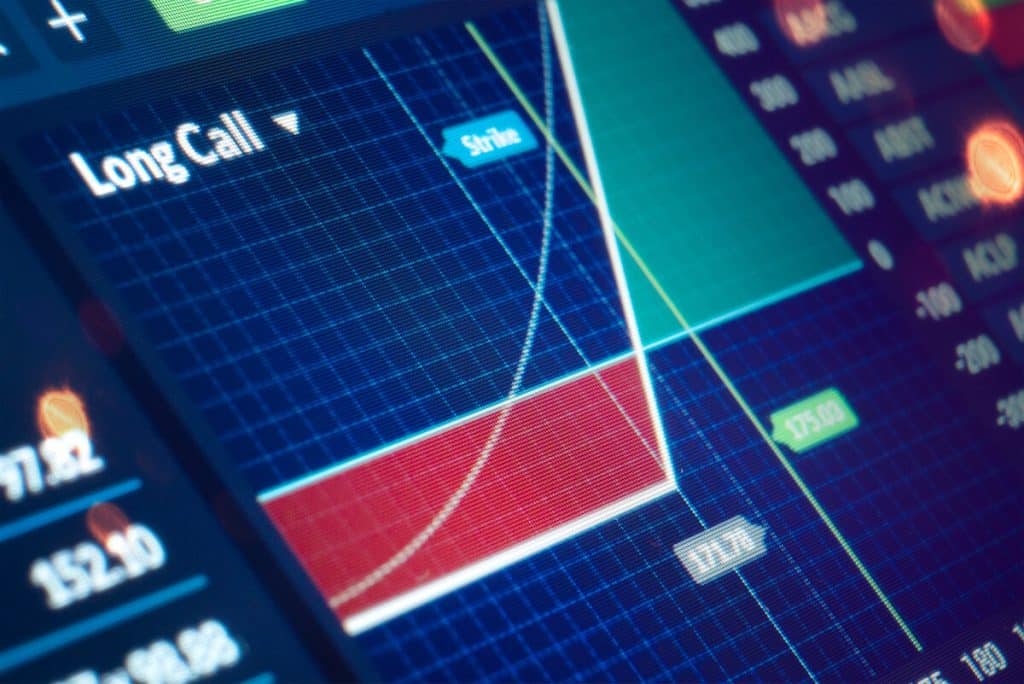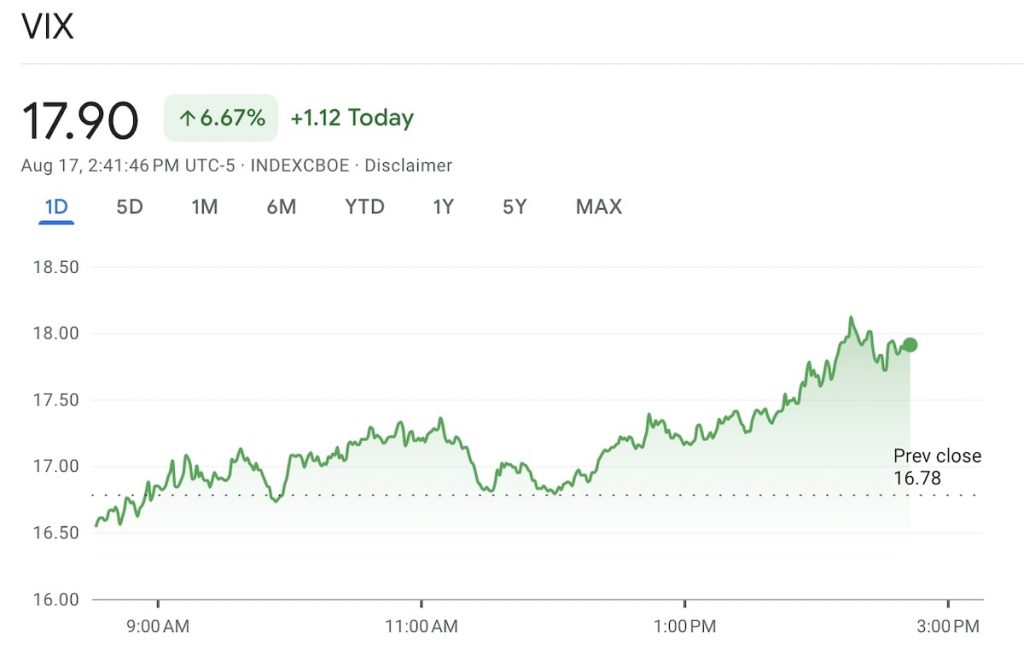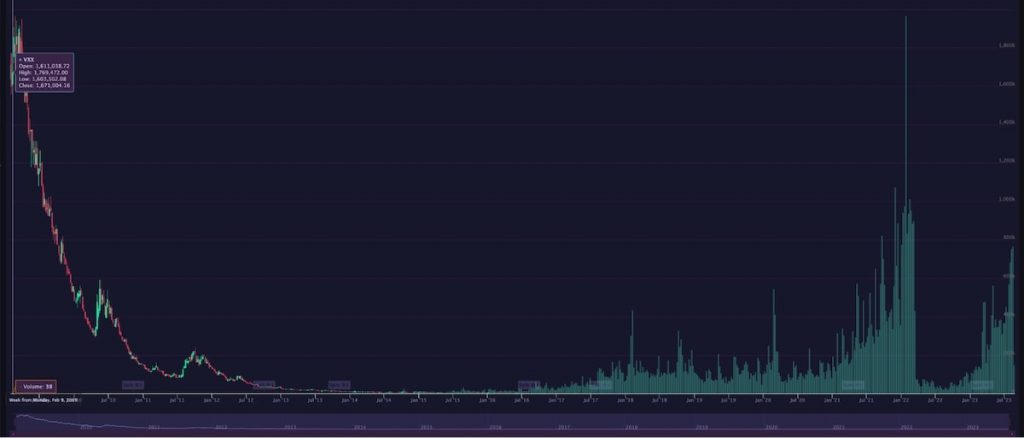
The Volatility Index (VIX) is managed by the Chicago Board Options Exchange (CBOE). It measures, monitors, and reflects how the market feels about the near-term volatility (30-day projections) of the S&P 500 Index (SPX) options price expiration dates.
Hence, the CBOE VIX can be used to trade on and profit from market volatility and fear- or hope-based sentiment. Investors and traders can long or short the VIX, use AI and algorithmic trading to execute fast-paced VIX trades, and include it in a widespread investment portfolio.
In this article, we explain how to trade the VIX and give you a more in-depth look at how to leverage fear, hope, and market volatility when making investments.
And just to make it clear, it’s technically not possible to trade the VIX since it’s an index, in other words, a math calculation. But what we can trade are derivatives around the VIX, that give us VIX exposure. This article will discuss these VIX derivatives and instruments.
What Is the CBOE Volatility Index?
Let’s start by clarifying the role of the CBOE with the VIX. Put simply, the CBOE created the VIX as a financial trading product that’s now bought and sold worldwide.
The Chicago Board Options Exchange (CBOE) is a stock, index, and futures exchange managed by CBOE Global Markets. The CBOE is a comparable and competing operation to the NYSE, NASDAQ, London Stock Exchange, and numerous others, except it’s smaller, relatively speaking.
It has been going for 50 years, and every day, it sees $63 billion traded in U.S. equities, 10 million U.S. options contracts, $43 billion in forex trading, and over 212,000 U.S. futures contracts.
The VIX, although derived from S&P 500 Index options price volatility, is a CBOE financial product, making CBOE “the home of the VIX.”
The VIX Index calculations are based on real-time, mid-quote S&P 500 Index call and put options. It’s a constant way of measuring and trading in 30-day SPX volatility.
The VIX serves two purposes. Like any financial product, it can be traded, and investors and day traders can do this in several ways ⏤ which will discuss later.
At the same time, as the CBOE says, the VIX is “one of the most recognized measures of volatility” and is closely followed and reported in the financial media as an indicator of the amount of fear, risk appetites, and hope impacting the movements of the stock market and market sentiment.
What Is Implied Volatility?
Stock markets are volatile. Share prices can go up, down, and sideways. Unless you’ve got a healthy appetite for risk, the ability to accurately predict the future (and the stock price data to back it up), and finely tuned AI-powered algorithmic trading tools to execute lightning-fast trades, you could quickly lose gains from sudden volatile price movement.
Unexpected price collapses can wipe out months or years of gains in hours or minutes. It’s essential that investors, brokers, and analysts understand volatility and how to calculate it, and then leverage this knowledge for investment strategies.
Uncertainty is another way to say volatility. If you’re unsure how much a particular security, index, commodity, futures contract, or forex price will fluctuate, it means you’re assessing its volatility. If you’re more sure about a security’s forward price movements, then the potential volatility is lower.
However, in more exact terms, volatility is a calculable metric used to statistically measure a security’s (or other financial asset’s) potential returns. Volatility can be calculated over any time period, from daily to annual timescales or longer.
For short-term traders, it’s more useful to calculate volatility over a more compressed timescale, such as the last 30 days. That’s the time period the VIX operates on.
Implied volatility is a forward-looking way of forecasting, as accurately as possible, expected or potential volatility in the future (as opposed to calculations that are historical in nature). One way to calculate it is with the Black-Scholes-Merton options and future-pricing model, using the fair or mid-quote price of a call or put option of a security.
A theoretical, data-backed, and backtested understanding of calculating volatility, with active knowledge of technical indicators, is useful for investors who want to know how to trade the VIX.
Why Should Investors Trade the VIX?

The VIX can be traded in numerous ways, including VIX futures contracts, index options, derivatives, exchange-traded funds, and exchange-traded notes ⏤ and through the CBOE’s VIX Suite.
The main reason market participants trade a volatility-based product is that it’s a way of hedging against the volatility of the S&P 500 Index. In most cases, VIX trading is simply part of a broader, risk-adjusted investment portfolio and strategy, whereby traders can offset wins and losses whether the market is bullish or bearish.
There’s a strong correlation between volatility on the S&P 500 and the VIX. If the SPX is falling, then the VIX goes up and vice versa, making it a useful weather-monitoring station for market sentiment.
Generally speaking, if the VIX is trading below $20, then the S&P 500 is probably stable, with low volatility. When the VIX price is above $30, then it’s a sign of volatility.
3 Considerations When Trading the VIX
Here are three considerations investors should take into account when trading the VIX.
1. Understand the Fundamentals of VIX Volatility Trading
At the end of the day, any VIX trading strategy is about being comfortable with calculating and predicting future volatility. In practice, this means understanding that VIX values are based on CBOE-traded SPX options.
These index options have a futures price that expires on the third Friday of each month, and the weekly SPX futures options expire every other Friday (at the close of trade). The only options used for VIX values are those that have expiration dates between 23 and 37 days. It’s a complex mathematical formula.
2. Respect the VIX S&P 500 Index Correlations
The correlation between the S&P 500 Index and the VIX is inverse. As mentioned earlier, if the SPX is going up, then the VIX falls and vice versa. It’s a way of measuring market fear (hence the VIX is known as the “fear index”), sentiment, and volatility, making those inverse correlations crucial for successful VIX trading.
3. Be Mindful That the VIX Is an Index
As is the case with any index, you aren’t trading an actual asset. As an index, the VIX can only be traded through derivatives that track the movements of the index.
For this reason, there’s usually a tiny lag between the prices you’re seeing through any product you’re using to trade the VIX and the actual real-time percentage price the VIX is trading at.
How to Trade the VIX: 5 Trading Options

Source: Google Finance
Now let’s take a closer look at how to trade the VIX, including a number of exchange-traded fund (ETF) and exchange-traded note (ETN) options.
1. CBOE’s VIX Trading Suite
One of the easiest ways to trade the VIX is to go straight to the source: CBOE’s VIX Volatility products trading suite. From here, you can trade in the VIX 24/7 through a range of products:
- VIX Index
- VIX Options
- VIX Futures
- Mini VIX Futures
2. ProShares Short VIX Short-Term Futures ETF (SVXY)
The ProShares Short VIX Short-Term Futures ETF is an exchange-traded fund that aims to generate daily returns that are equal to one-half of the daily inverse takings of the S&P 500 VIX Short-Term Futures Index.
It’s a short-term trading ETF rather than something you can use for long-term investments, and it aims for an inverse return from a single-day benchmark. SVXY calculates this based on the net asset value from one day to the next. Monitor this investment closely, as inverse ETFs are risky and can cause considerable losses if held for more than one day.
Day traders investing in the VIX through the SVXY ETF can expect to pay 0.95%.
3. ProShares VIX Mid-Term Futures ETF (VIXM)
Similar to the above, this is another ETF, except it tracks mid-term VIX futures contracts with five-month expiration dates. VIXM helps investors aim to profit from expected or predicted S&P 500 Index volatility in the mid-term. The VIXM expense ratio is 0.98%.
4. iPath Series B S&P 500 VIX Mid-Term Futures ETN (VXZ)
One of the most common ways to trade the VIX is through exchange-traded notes rather than ETFs. The iPath Series B S&P 500 VIX Mid-Term Futures ETN was first launched in 2009 and expired in 2019.
This is the second iteration of that same ETN, with a 30-year expiration date (January 23, 2048) issued by Barclays Capital, with an expense ratio of 0.89%. The VXZ performs better for short-term investors, as there is a penalty for long-term holders. It tracks long-hold positions in first- and second-month VIX futures contracts.
5. iPath Series B S&P 500 VIX Short-Term Futures ETN (VXX)
Similar to the above, the VXX is another Barclays Capital-issued 30-year ETN with an expense ratio of 0.89% and an expiration date of January 23, 2048. This ETN holds positions in futures contracts issued in the fourth, fifth, sixth, and seventh months of the year. It also produces better returns for investors in the short term rather than the long term, thanks to the negative roll yield.
The cost you will pay to own VXX, and other VIX ETFs, is actually much more than just the expense ratio. Due to the roll, and that put options have an inherent premium, you will lose value over time on VIX ETF derivatives. To see the full impact, pull up a price chart of adjusted close prices, which take into account reverse splits and show the hidden cost of owning VIX derivatives.

You can see how much money you would lose holding VXX long term.
Start Trading the VIX and Plug in Real-Time Volatility Index Data
Trading the VIX is a great way to benefit from short-, mid-, or long-term price volatility in the S&P 500 Index. It’s known as the “fear index” for a reason, and the correlation between the VIX and SPX is inverse.
Investors and day traders can’t trade the VIX directly, as it’s an index. However, there are numerous derivative products on the market, such as ETFs, ETNs, futures, and options.
Now that you know how to trade the VIX, you need to decide on your strategy. One of the best ways to develop a smart VIX investment strategy is to plug in real-time volatility data to your investment and trading platform. You can do that with Tiingo, a high-quality data source for volatility price calculations and VIX-based trading strategies.
Leave a Reply